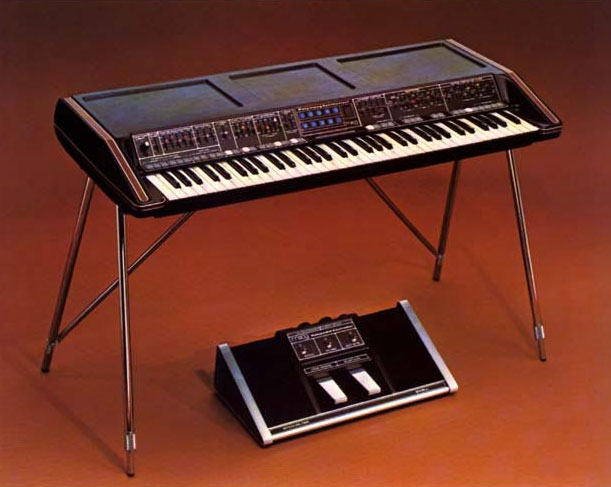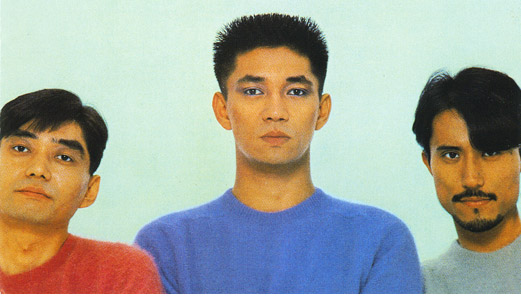Moog synthesizers were the second of the modular synths to be marketed to the public. The company was founded by Raymond Scott’s former assistant, Robert Moog, an electronics genius who built and sold theremins in the 50s. The company was first called R.A. Moog Co. which later became Moog Music. The first Moogs—the 900 series—were marketed in 1967 after a former student of Ussachevsky named Walter Carlos (now Wendy Carlos) began buying up Moog modules to use on his own system and made suggestions to Bob Moog on how to improve on them. Moog deserves credit for standardizing much of the synthesizer industry. The first Moogs were huge and heavy and the oscillators went out of tune when hot. One could spend hours retuning them or trying to program a new sound. Consequently, Moogs found a residence in classrooms, labs and studios but few homes other than professional musicians. Carlos bought the first. The second was bought by—believe it or not—Buck Owens for the 1971 Capitol album
Switched-On Buck consisting of Owens’ songs played on the Moog by his friend and collaborator Jeff Haskell. Mickey Dolenz bought the third one. In fact, the Monkees were the second band to feature a Moog just after the Doors, both in 1967. The Byrds and Simon & Garfunkel recorded with one in 1968. The Beatles used one on
Abbey Road in 1969. The most popular Moogs turned out to be the minimoog and the polymoog (other Moogs were monophonic). Moog Music declared bankruptcy in 1986 but Bob Moog’s company, Big Briar, renamed itself Moog Music in 2001 due to the rising demand for analog synths.

Dr. Robert Moog and synthesist/keyboardist extraordinaire Keith Emerson who popularized the Moog even more than Wendy Carlos had done. Emerson even took his huge Moog system on grueling tour schedules—the first musician ever to do so. It weighed several hundred pounds and required a separate road crew to break it down and set it up.

A typical Moog setup of the 70s. Each module was a separate signal generator/processor. The patch cords simply routed the signal through the various modules. Contrary to what some might believe, synths as this were not computers. The Moog simply produced a sine wave generated by an oscillator and ran it through various band filters to remove high, low or medium frequencies to create totally different wave forms. This is called subtractive synthesis. Additive synthesis, where harmonic waves are added to a basic sine wave to reshape the timbre, was a bit more complicated and so most synths of that period were subtractive.

The recording that brought the Moog synthesizer into the public mind, Walter Carlos’s 1968 release
Switched-On Bach in collaboration with Rachel Elkind who produced it. Modern versions of this recording now say Wendy Carlos. Carlos also did an updated version of this recording with MIDI called
Switched-On Bach 2000.
silver apples on the moon - YouTube
Morton Subotnick's
Silver Apples of the Moon was another early composition that ushered the Moog into the public mind. This is perhaps the coolest clip on the internet.

The minimoog, a portable Moog synth. Although severely restricted by its size, it was still versatile and was used by Keith Emerson, Rick Wakeman, Manfred Mann, Gary Wright, Kraftwerk, Tangerine Dream, The Captain and Tenille and many others.

The polymoog, the first polyphonic Moog synth. Many bands swore by it. Gary Numan made it his band’s primary instrument and raved about it in interviews. It provides all the keyboard sounds including the electronic percussion beat heard in his hit “Cars.” Because both hands could now occupy the keyboard simultaneously, many of the adjustable settings were moved to a foot-operated unit. Kraftwerk used one as did Wendy Carlos, Rick Wakeman, Tony Banks (Genesis), John Foxx and the polymoog sound is heard on every Blondie album. It was quickly outclassed, however, by later polyphonic synths and became somewhat of a joke to many keyboardists but it was quite revolutionary for its time.
Gary Numan - A Dream of Siam - YouTube

Yellow Magic Orchestra of Japan were avid Moog users who crafted pop and disco numbers electronically in the 70s and found a large following both in and outside of Japan. They are today recognized as pioneers in the field of electronic popular music. They also used the minimoog and the polymoog extensively.
Yellow Magic Orchestra (YMO) - Computer Games - YouTube
There is little doubt that "Computer Games" is YMO's signature song--a huge disco house party favorite in the US which even got them on "Soul Train." This band contained Ryuichi Sakamoto who went onto have a successful solo career. Sakamoto played the camp commandant in the movie "Merry Christmas, Mr. Lawrence" which he also wrote the score for (excellent score, btw). David Bowie also appeared in the movie and both he and Sakamoto have recorded together. Sakamoto was a part-time member of the British band, Japan, and wrote the music for "Taking Islands in Africa" as well as playing all the music tracks (all synthesized) which David Sylvian sang over.